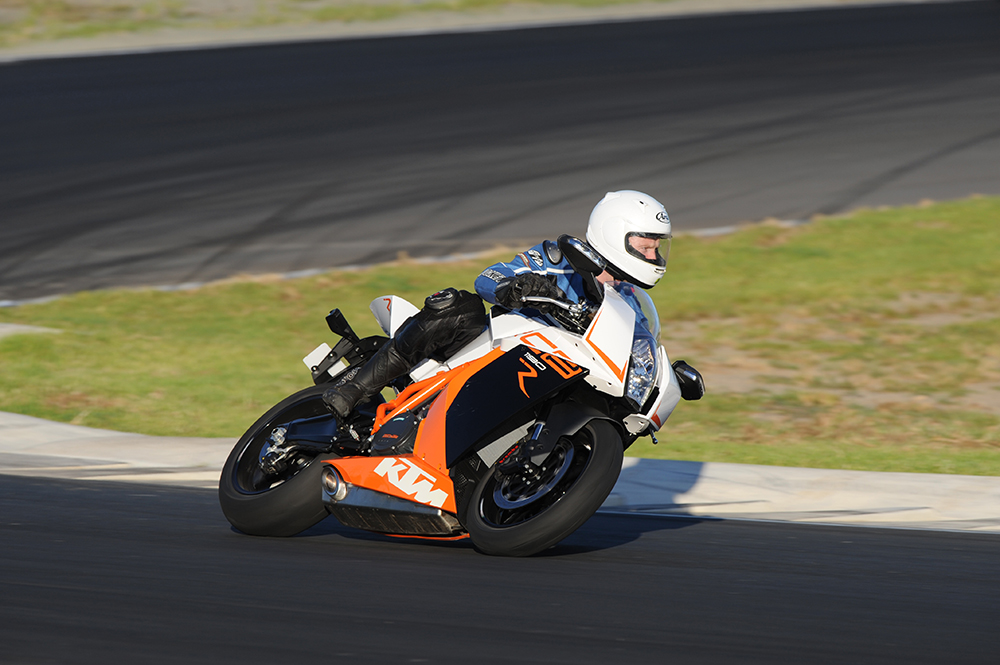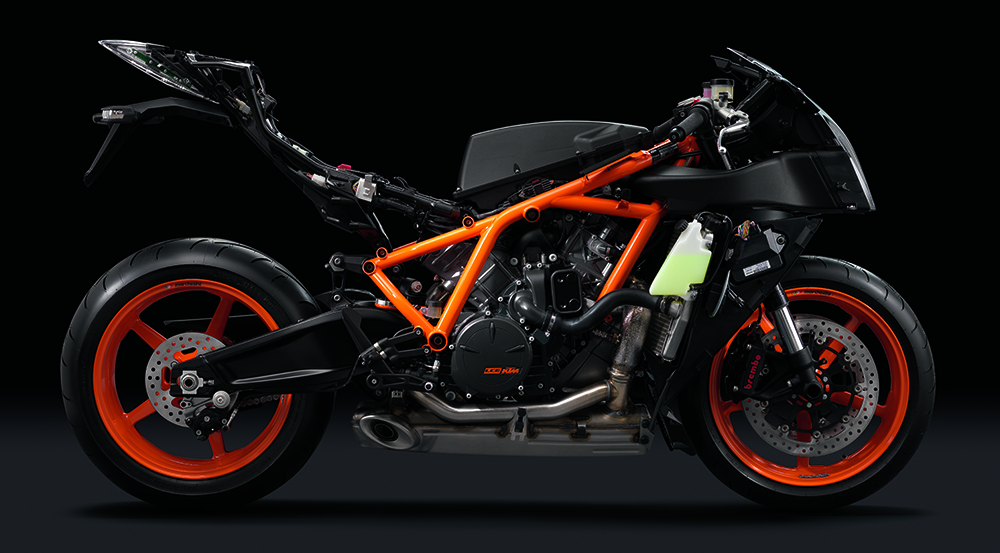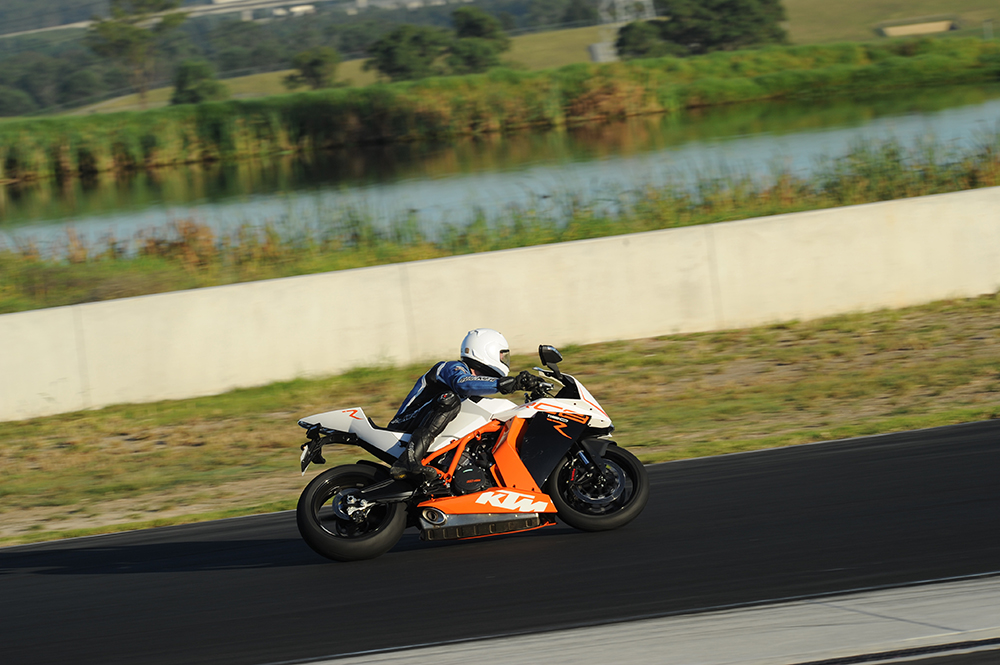How dId KTM’s flagship superbike stand up to the brand’s motto when we tested back in 2012?
Casting my mind back to the first sampling of the then eagerly awaited RC8; a customer at the bike shop I worked at rocks up full of the glee new-bikehood brings. I didn’t ask, but he threw me the keys and 40km later the verdict is in. The world had waited a long time for the original to turn up, so the presence of fuelling gremlins and gearbox glitches was as surprising as it
was unwelcome.
That was ’09. In theory this is ancient history, but lore travels as fast as rectification news travels slow. I have a vision of existing owners’ nods recalling how many sages have questioned their gearboxes operation.
So to the second first impression, if you’ll pardon the paradox. Stance: KTM’s new RC8 R looks pointy in styling as well as chassis capability. It hangs together very neatly as well, as every new bike should; cabling routing and component position is unobtrusive. After taking delivery and rolling for two seconds to park the bike in the smelly depths of the Horror dungeons, something very odd shines through – it’s really roomy. On the stock set-up there is a spacious, relatively conservative riding position buried under the styling’s optical illusion. If you assumed it would be uncomfortable, well you know what assumptions make. Apply that to the gel seat, the gel gives way to offer sound support. Bear in mind too, all sorts of everything is adjustable – bars, footpegs, seat height and of course levers – and the bike arrived on the scrunched-up settings for my 184cm height. The cod liver oil options for those of us that creak are that bit better again, by expanding the ride position, bar the rear brake height which may as well be mounted on the reg plate for all
its accessability.

First ride, second corner and the front wheel seems up there somewhere. The slight hesitation in steering suggests these things arrive on the safety-first ride height settings, presumably to assist keeping the overzealous out the ditch. The upsides of this are less weight on creaky wrists and a higher degree of stability. Ease of turn-in is hardly affected due to fitment of lightweight Marchesini wheels (flash types that opt for the track-spec RC8 R get forged wheels; the increase in strength allows a little less material. Nicey but pricey).
But that gets ahead of ourselves as currently we’re sat at the lights, soaking up the admiring glances, revelling in the easiest, clearest found neutral in memory. And admiring looks/stupid questions will follow you around. There are 30 of these available this year, so they will remain an infrequent treat.
No coughing or spluttering about the supposed discrepancy of missing ponies, 150hp is right on the money for a 1200 V-twin. Gloating from owners of other European 1200 V-twins, red ones for instance, could be easily silenced. This thing’s torque characteristics are much more linear and applicable to the majority than the short-stroke semi-two-stroke other route to big numbers out of a V-twin.
As you would expect with 149.9bhp (111.8kW, measured) and 113 Nm drivability out of faster corners is great, subject to some caveats. The first is something you’ll get used to – the throttle is very light. Holding onto the bars, as opposed to just pointing steering, can cause jumps of gas. The ergonomic tank shape helps you counter this by allowing a tight grip.
The second is gearing. The changes to last year’s model are mechanically few, so while supposition only, the new slipper clutch could be louder. Certainly the gearing didn’t need raised from last year’s 17/38 to the 17/37 found now. All large-capacity, large-performance V-twins do seem to sail close to the drive-by noise test wind, and why else would you opt to drop the revs? This may appear small, but snoozing under the speed limit effectively means a four-speed gearbox, fifth for dawdling on motorways and sixth… er, never. Below 3300rpm in the higher gears feels mechanically unfriendly; the RC8 R needs to spin.

An interesting point upon start-up is a reminder on the clocks if you’re in 98 RON fuel mode. The RC8 R runs a massive 13.5:1 compression ratio. Once the realms of methanol-burning racebikes, now the solution to emissions targets. Unless you’re built like Thor, bump-starting is never going happen and it would be worth watching for a cold engine stalling unexpectedly because of it. Sticking to the higher-grade fuel would be preferable as power and, much more importantly, delivery is better in the higher fuel rating mode. Not to mention detonation could do significant engine damage. Changing between modes on the dash – indeed all the whizz-bangs are relatively straight forward – you just need to understand the buttons. Press is different to press and hold, is different to press and hold then press either the + or – button. Then after all that press the mode button again to save the new required setting. Not difficult, just a little different.
My riding commenced in road mode with the discovery of race mode taking a while, and upon completion I raced to base via the same route in reverse. Power changed by just 2.869bhp… which is a flippant admission I failed to notice a difference in the amount or delivery. An inspection of the dyno printouts suggested it may as well stay in race mode, as this has a smoother delivery.
Open out the road and the bike wants to show what it’s for. The front suspension is made by fellow Austrian company and long-time KTM supplier, WP, and gives an impression of quality and feedback. WP has long been known as a provider of quality suspension but the company has expanded into other manufacturing areas; exhaust systems, radiators and frames are currently on the bill. It also makes the frame for the RC8 R.

Re-affirming race pedigree and the lithe V-twin shape is a pair of mirrors embarrassed by association to any charitable verb. Shoulder inspections aren’t the only issue as KTM has made the bars adjustable however neither position completely clears the mirrors, and
any glove with much knuckle protection fouls quite annoyingly.
The mirrors aren’t all bad as they contain the indicators, a neat touch and there’s a whiff of a conspicuousness bonus; not like KTM to conceal orange-ness with clear lenses, though.
One of the clearly visible instrument lights on the large dash is the fuel level warning. Me and it are very familiar. The tank capacity is only 16.5 litres and within this resides an alleged 3.5-litre reserve. Someone forgot to tell the fuel sender the last bit as the worry light comes on a litre early, meaning I’ve run out of bottle to continue riding with around 40 kay of fuel hiding in the bottom of the tank. Another few litres capacity would be nice; it is every bit pleasant and capable to pilot for longer distances so the enforced stops can grate. Used spiritedly on track confirms this; take a jerry can to your ride-day.
If you’re in the market for something this dedicated, this is every bit the valid choice. There is some stiff V-twin sportsbike competition in the Ducati Panigale 1199, itself an excellent bike, but the KTM has its own appeal. Anyone who revels in using a bike in freer environment ought to enjoy a long and happy relationship, comfortable in knowing it’s unusual enough to be noticed while although from a smaller manufacturer, it’s one that produces robust, capable and very reliable machines.

WORDS Andy Carlile PHOTOGRAPHY Keith Muir and SM